The Art Detective
The Horse Trading Behind the Ecstatic, $3 Billion Mark Rothko Exhibition at Fondation Louis Vuitton
The show is the "fulfillment of a long-standing personal wish” of Bernard Arnault. No expense was spared.
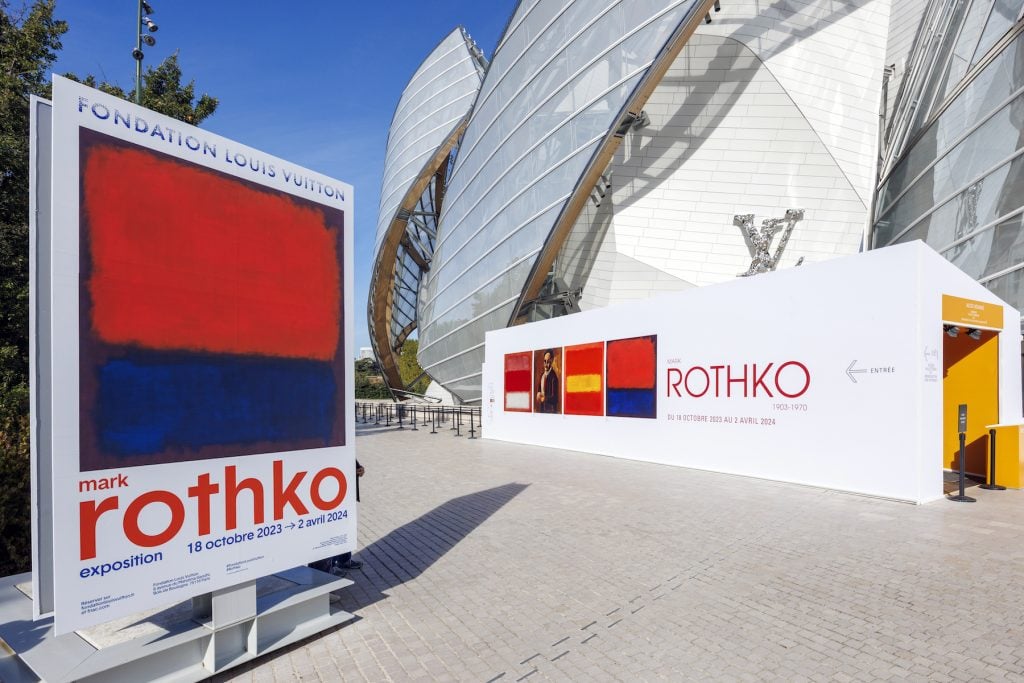
The show is the "fulfillment of a long-standing personal wish” of Bernard Arnault. No expense was spared.

Katya Kazakina

“Tragedy, ecstasy, doom, and so on…,” Mark Rothko said in 1957, when asked what he hoped to convey through his paintings. “And if you, as you say, are moved only by their color relationships, then you miss the point!”
Last week, the breadth of Rothko’s vision was revealed on a scale unprecedented in 25 years at the Fondation Louis Vuitton in Paris. There, 115 paintings by the Abstract Expressionist master hung in hushed rooms that seemed to have been built just for them.
The art world was already gathered for the newest iteration of Art Basel in the French capital, heightening the spectacular show’s impact. Judging from breathless proclamations both on social media and in the press, the assembled art lovers eagerly prostrated themselves in front of these somber and ecstatic canvases.
The survey, as Jason Farago wrote in the New York Times this week, is a “pull-out-all-the-stops blockbuster where life passes into vapor.” He claimed to have been a Rothko skeptic before his visit to the Fondation. Yet after, Farago declared that getting through life without these paintings feels “ridiculous.”
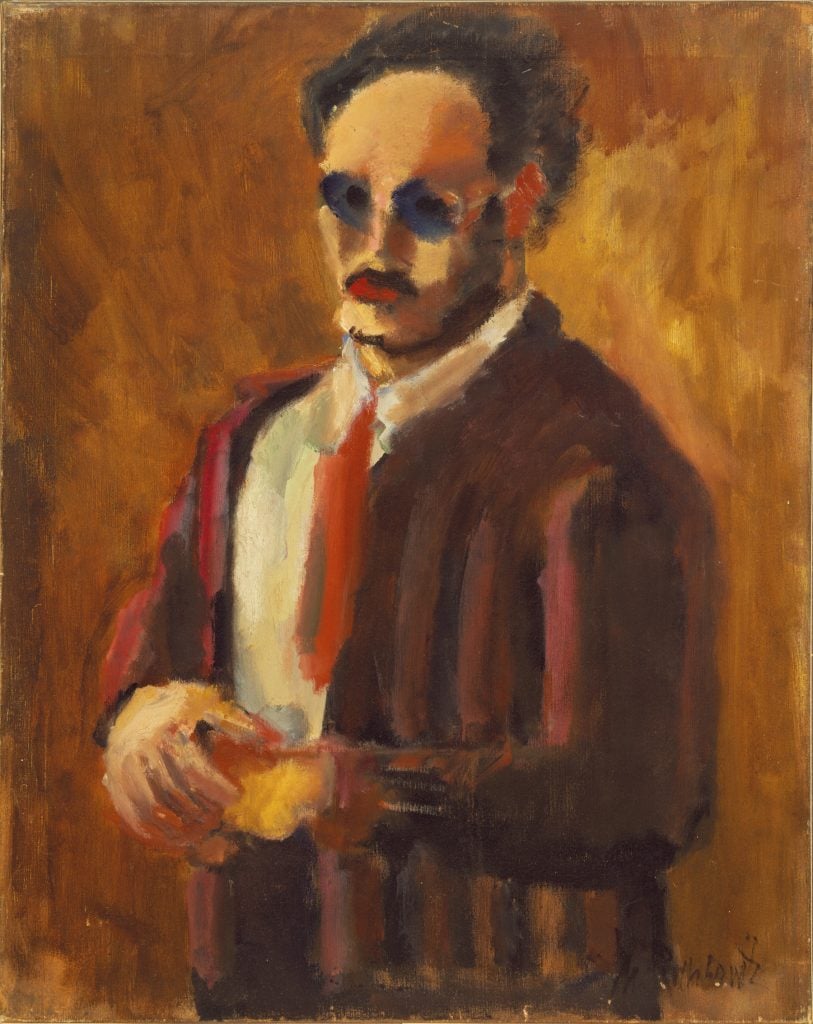
Mark Rothko, Self Portrait (1936).
Collection of Christopher Rothko
© 1998 Kate Rothko Prizel & Christopher
Rothko – Adagp, Paris, 2023.
It wasn’t lost on many that their creator, a Jew born Marcus Yakovlevich Rothkowitz in 1903 in czarist Russia’s sprawling Jewish ghetto, known as the Pale of Settlement, was a member of the same persecuted tribe whose very existence is once again igniting hate and violence around the world.
“Because of the enormity of the world’s sorrow, the show felt extraordinarily timed,” said art adviser Janis Gardner Cecil. “It was a really needed experience.”
It was also not lost that an exhibition like “Mark Rothko” could not have been done just anywhere today. The foundation was built by Bernard Arnault, the world’s second richest man with a net worth of $154 billion, according to Bloomberg Billionaires Index.
The retrospective “is the fulfillment of a long-standing personal wish,” the chairman of LVMH Moet Hennessy Louis Vuitton, the world’s largest luxury goods maker, wrote in the lavish exhibition catalogue. “Rothko is one of my favorite artists. Yet he is still too poorly known and acknowledged in France and Europe. I therefore wanted the Fondation to redress this injustice, to fill an unfortunate gap largely explained by his underrepresentation in museums and collections here.”
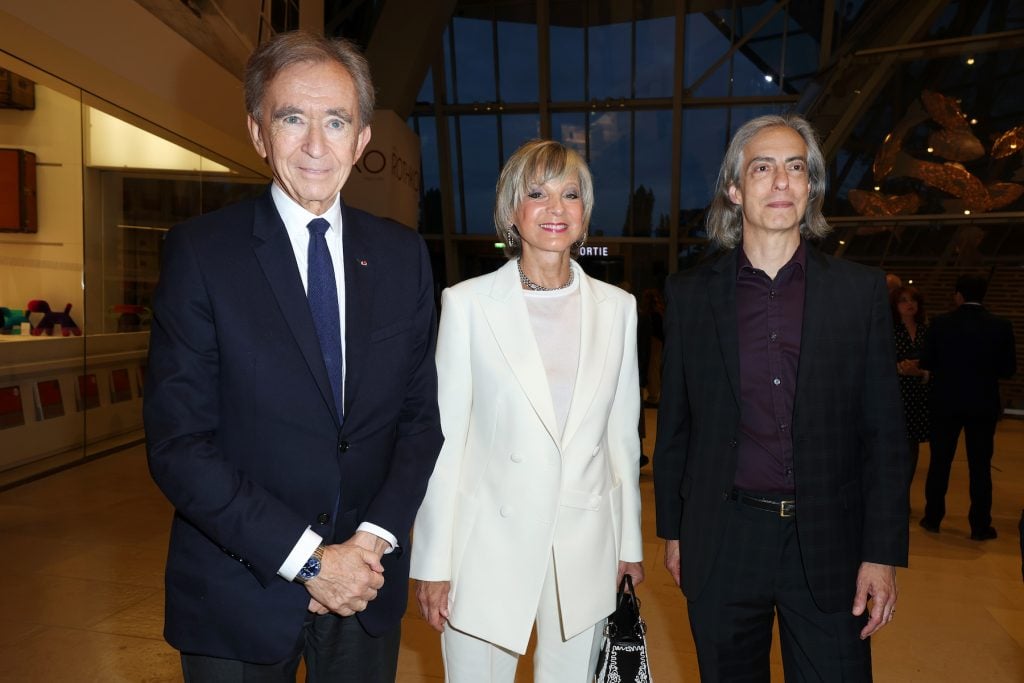
Bernard Arnault, Hélène Mercier-Arnault and Christopher Rothko at La Fondation Louis Vuitton on October 17, 2023 in Paris, France. (Photo by Pascal Le Segretain/Getty Images)
To do so, Arnault turned to Rothko’s children, Christopher Rothko, who was 7 years old when his father committed suicide, and Kate Rothko Prizel, who launched and won the epic legal battle to regain control over his estate.
Their participation and personal art loans lent credibility to the undertaking, which has been more than four years in the making.
Christopher Rothko, who co-curated the exhibition with Suzanne Pagé, approached many museums asking for loans. A staggering number of institutional lenders said yes, including 25 from the U.S., six from Europe, one from Asia, and one from Canada. The National Gallery of Art sent 13 paintings from Washington, D.C. Tate Modern in London emptied out its gallery full of Rothko’s monumental Seagram paintings. The Museum of Modern of Art, the Metropolitan Museum of Art, the Whitney, and SFMoMA all shared their treasures.
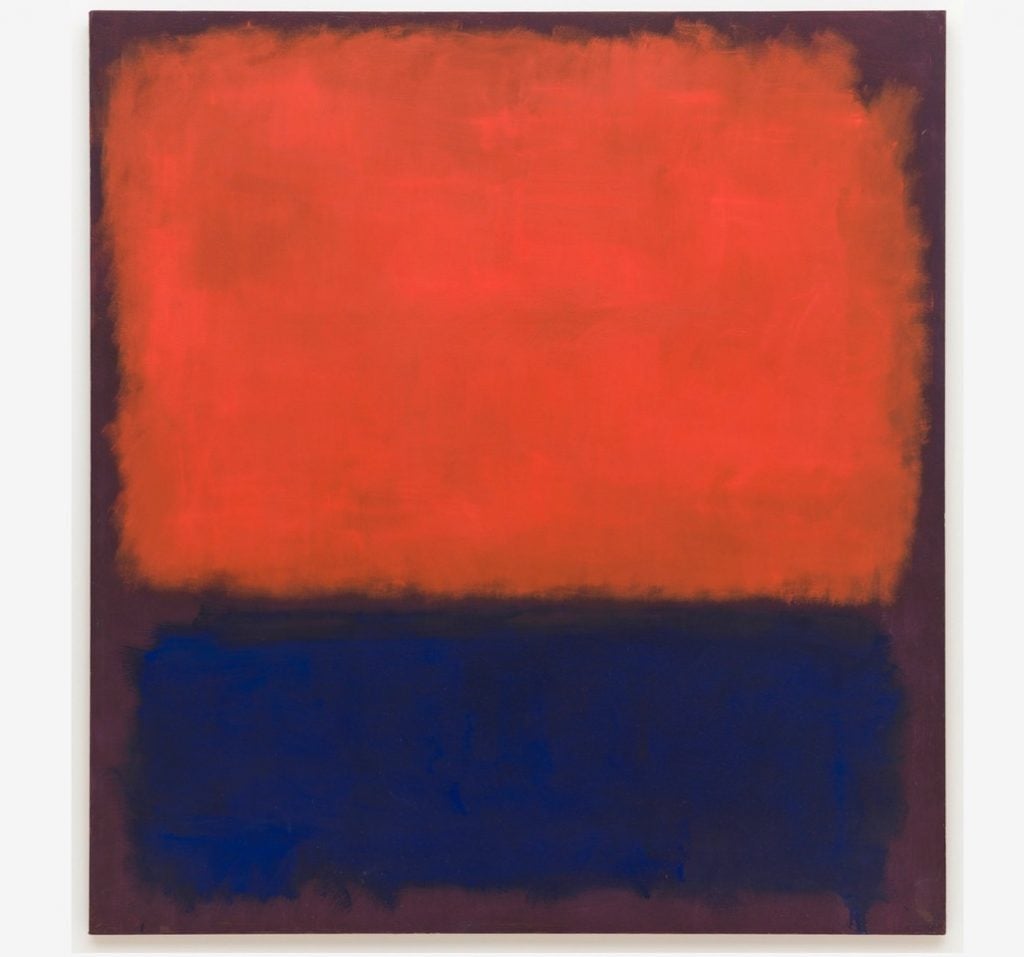
Mark Rothko, No. 14 (1960). San Francisco Museum of Modern Art—Helen Crocker Russell Fund purchase © 1998 Kate Rothko Prizel & Christopher Rothko – Adagp, Paris, 2023.
“We would not be able to do a show like this in Toledo,” said Adam Levine, director of Toledo Art Museum, which lent its sole Rothko, a magnificent untitled 1960 work, to the exhibition. “It would be prohibitively expensive.”
Bringing together artworks from many sources was “a priority for me,” said Christopher Rothko. He made a wish list of paintings by flipping through Rothko’s catalogue raisonné.
“I didn’t want to create just another retrospective that looked like the last three or four,” he said, noting that in the past they had relied mostly on the family and the National Gallery of Art, which owns 1,100 paintings and works on paper by the artist, the largest depository of Rothko’s oeuvre.
It’s the latest mega-exhibition mounted in the Fondation’s gleaming futuristic compound designed by Frank Gehry. It comes on the heels of a market-making pairing of Joan Mitchell and Claude Monet, a blockbuster Jean-Michel Basquiat show, and some unforgettable surveys of modernism commemorating visionary Russian turn-of-the-20th century collectors Ivan Morozov and Sergei Shchukin.
“These shows that the Louis Vuitton Foundation has done one after another, they’ve been masterstrokes of curation—and, honestly, it’s a flex,” said adviser Wendy Cromwell. “To pull off these shows you need unbelievable resources.”
Museums and collectors loathe parting with their prized artworks. Each journey and each exhibition is a stress test—or worse—for canvases that may appear timeless but are actually pretty old. And so there are lengthy processes in place to evaluate loan requests, looking at facility reports, the show’s importance, and other participating institutions. The Met, for example, requires such requests to be submitted at least 12 months in advance and may charge loan fees.
The National Gallery of Art (NGA) spent months considering Christopher Rothko’s proposal.
“It was an iterative process in which we went back and forth to see what we could accommodate, and in which he gradually refined his needs,” said Harry Cooper, NGA’s senior curator and head of modern and contemporary art, responding to the Art Detective’s questions. “Obviously, they had to be works that were not committed elsewhere and were also approved for travel by painting conservation. Other than that, as much as possible, we wanted to give the curators their choice for such an important exhibition given our mission to promote the appreciation and study of Rothko’s work.”
Lending its Rothkos meant that the NGA had to rehang the museum’s Rothko Tower and Abstract Expressionist gallery, where many works had been installed. The museum replaced them with “similar works,” Cooper said.
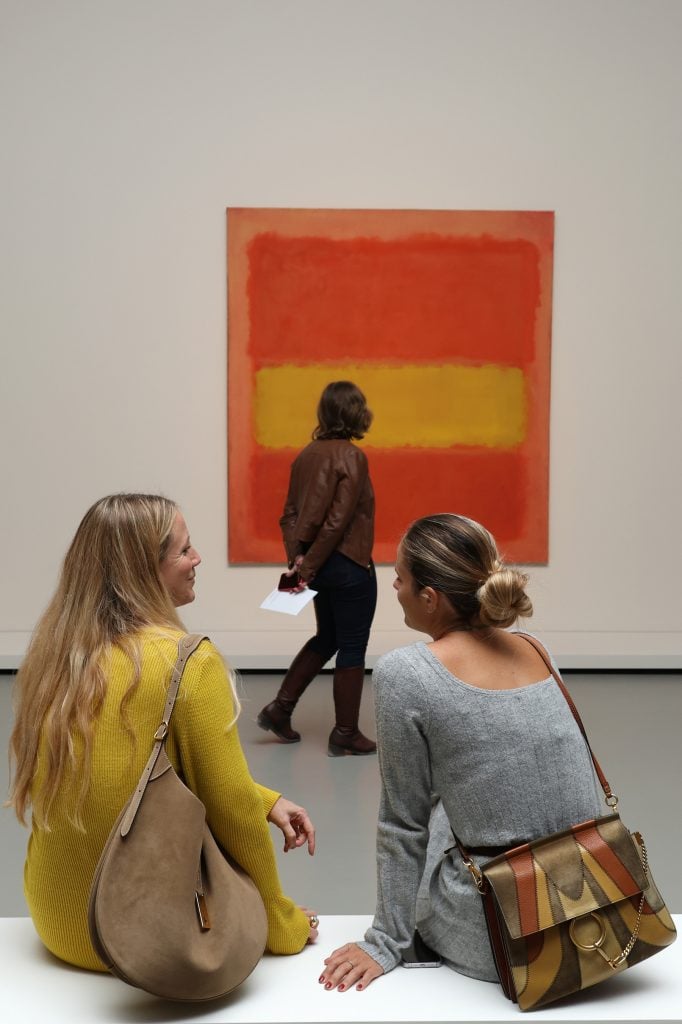
General view during the opening of “Mark Rothko” at La Fondation Louis Vuitton on October 17, 2023 in Paris, France. (Photo by Pascal Le Segretain/Getty Images)
There’s a lot of horse trading happening behind the scenes. Reciprocal loans among museums are common. Tate Modern, for example, got a room full of Mitchells from Fondation Louis Vuitton as a reciprocal loan for its Seagram paintings. The Phillips Collection in Washington, D.C. received three Rothko paintings from Rothko’s children in exchange for the three Rothkos it lent to the exhibition in Paris, according to Pagé, the show’s co-curator and artistic director of Fondation Louis Vuitton.
“My first discussions with the Tate started about four years ago, but even so the conversations were part of a longstanding and close friendship that I have enjoyed with the Tate over many decades,” Pagé said. “The Tate lent Seagrams for my previous Rothko show at the Musée d’Art Moderne de la Ville de Paris in 1999.”
For the current show, the Tate lent nine Seagrams as part of an exchange of loans and received nine works by Mitchell, which are currently on view at the museum in London, she confirmed.
The Rothko siblings lent paintings from their personal collections to a handful of smaller museums whose paintings they borrowed for the big show. “I don’t think we had hardball negotiations,” Christopher Rothko said. “I wasn’t hesitant to loan.”
One major hurdle in putting together mega shows is insurance, museum executives said. Paintings must be insured for their fair market value. With values rising for modern and contemporary art, more exhibitions than ever before threaten to strain global capacity, which currently stands at about $4.2 billion for a single exhibition, according to Mary Pontillo, national fine arts product leader at Risk Management insurance company.
Let’s consider the value of art assembled in the Bois de Boulogne at the moment.
Asked to estimate, dealers and advisers I spoke to unanimously proclaimed: Billions.
Staggering as it sounds, it’s easy to see how we can arrive at that figure.
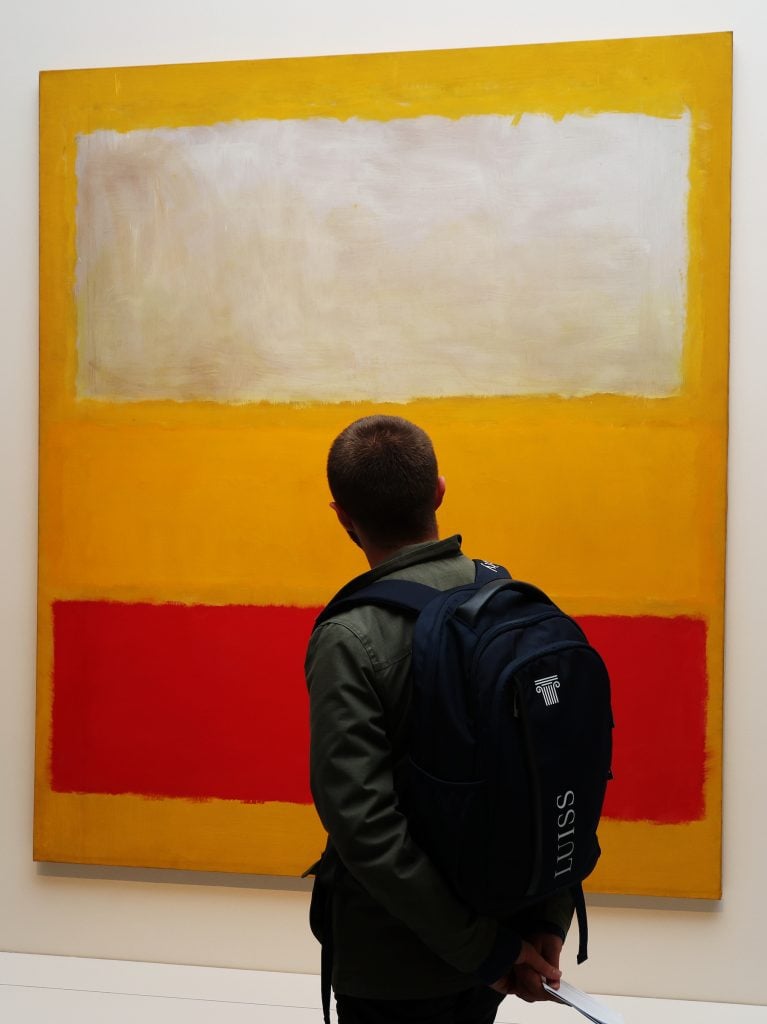
“Mark Rothko” at the Louis Vuitton Foundation in Paris on October 17, 2023 in Paris, France. (Photo by Luc Castel/GettyImages)
Just three paintings by Rothko currently on the market are jointly estimated at more than $115 million. The priciest of the three, 1955 Untitled (Yellow, Orange, Yellow, Light Orange), is being sold by Steve Wynn at Christie’s, where it’s estimated at $45 million. A 1958 Untitled from the collection of Emily Fischer Landau is estimated at $30 million to $40 million at Sotheby’s. And Pace gallery offered Thomas H. Lee’s Olive over Red (1956) at $40 million in Paris + art fair this month.
A typical price range of the types of mature Rothko paintings at Fondation Louis Vuitton is $40 million to $80 million, market experts said. Several works are valued at more than $100 million. At least one—SFMoMA’s breathtaking No. 14 from 1960—was flagged to me by dealers and auction executives as a $200-million-plus painting.
(Such speculations are a mental exercise, to be sure, because none of the paintings at the Fondation are actually for sale—for the moment—although it is not unheard of for some to come to auction following blockbuster exhibitions.)
My back-of-the-envelope calculation puts the contents of this show at a $3.2 billion, roughly. Museums and the foundation declined to discuss insurance values.
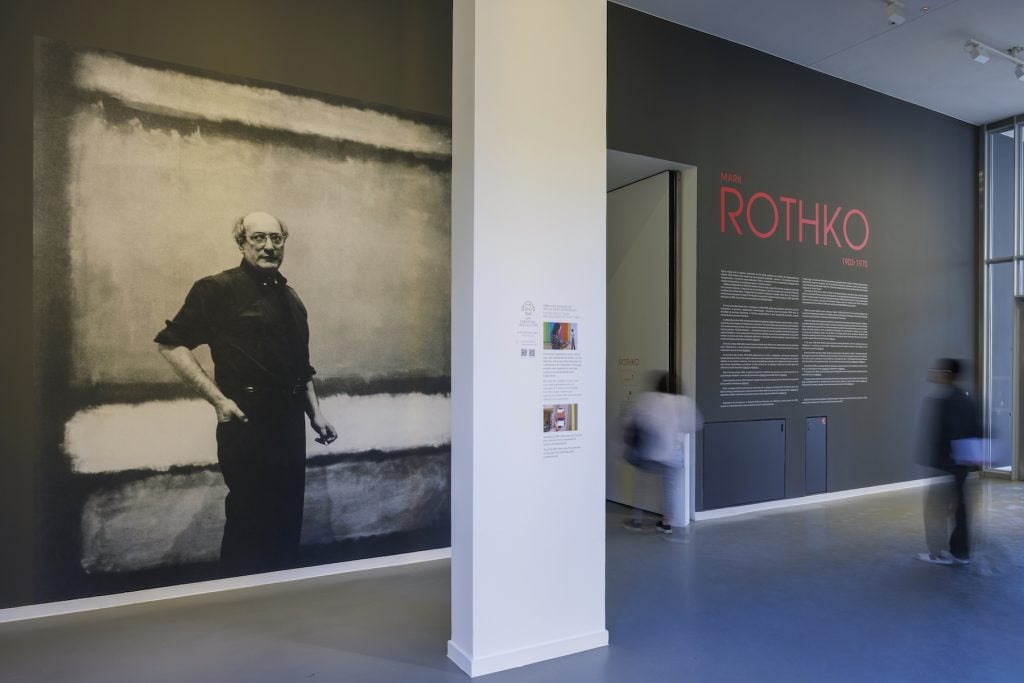
“Mark Rothko” at the Louis Vuitton Foundation in Paris on October 17, 2023 in Paris, France. (Photo by Luc Castel/GettyImages)
Finally, there are shipping and crating costs to think about, which can run into tens of thousands of dollars for each painting. Many paintings in the show are massive. Two of the Seagram works, Black on Maroon and Red on Maroon, both from 1959, are 9 feet tall and 15 feet wide.
Individual museum crates may cost as much as $30,000, according to Fritz Dietl, who runs a logistics empire. And paintings of this value and significance often have to be accompanied by a courier, who keeps an eye on them at every moment.
Clearly, no cost has been spared by the Fondation Louis Vuitton, which remained mum on the budget of the show.
“I wasn’t involved in the budgeting,” said Christopher Rothko. “I am sure it was very, very expensive. They were willing to make sure that this was the best quality exhibition, and were willing to pay the cost.”
The resulting show speaks to the common human experience and art’s power, he said.
“In the face of all sorts of crises and tragedies—and the last couple of weeks have been more than full of both—my father’s art reminds us of the importance of human expression,” Christopher Rothko said, “and of the art that can reengage us.”